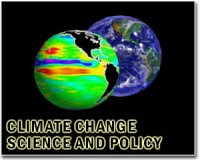| . |  |
. |
Boston MA (SPX) Nov 04, 2010 Weather systems in the Southern and Northern hemispheres will respond differently to global warming, according to an MIT atmospheric scientist's analysis that suggests the warming of the planet will affect the availability of energy to fuel extratropical storms, or large-scale weather systems that occur at Earth's middle latitudes. The resulting changes will depend on the hemisphere and season, the study found. More intense storms will occur in the Southern Hemisphere throughout the year, whereas in the Northern Hemisphere, the change in storminess will depend on the season - with more intense storms occurring in the winter and weaker storms in the summer. The responses are different because even though the atmosphere will get warmer and more humid due to global warming, not all of the increased energy of the atmosphere will be available to power extratropical storms. It turns out that the changes in available energy depend on the hemisphere and season, according to the study, published Monday in the Proceedings of the National Academy of Sciences. Fewer extratropical storms during the summer in the Northern Hemisphere could lead to increased air pollution, as "there would be less movement of air to prevent the buildup of pollutants in the atmosphere," says author Paul O'Gorman, the Victor P. Starr Career Development Assistant Professor of Atmospheric Science in MIT's Department of Earth, Atmospheric and Planetary Sciences. Likewise, stronger storms year-round in the Southern Hemisphere would lead to stronger winds over the Antarctic Ocean, which would impact ocean circulation. Because the ocean circulation redistributes heat throughout the world's oceans, any change could impact the global climate. O'Gorman's analysis examined the relationship between storm intensity and the amount of energy available to create the strong winds that fuel extratropical storms. After analyzing data compiled between 1981 and 2000 on winds in the atmosphere, he noticed that the energy available for storms depended on the season. Specifically, it increased during the winter, when extratropical storms are strong, and decreased during the summer, when they are weak. Because this relationship could be observed in the current climate, O'Gorman was confident that available energy would be useful in relating temperature and storminess changes in global-warming simulations for the 21st century. After analyzing these simulations, he observed that changes in the energy available for storms were linked to changes in temperature and storm intensity, which depended on the season and hemisphere. He found that available energy increased throughout the year for the Southern Hemisphere, which led to more intense storms. But for the Northern Hemisphere, O'Gorman observed that available energy increased during the winter and decreased during the summer. This makes sense, O'Gorman says, because the changes in the strength of extratropical storms depend on where in the atmosphere the greatest warming occurs; if the warming is greatest in the lower part of the atmosphere, this tends to create stronger storms, but if it is greatest higher up, this leads to weaker storms. During the Northern Hemisphere summer, the warming is greatest at higher altitudes, which stabilizes the atmosphere and leads to less intense storms. Although the analysis suggests that global warming will result in weaker Northern Hemisphere storms during the summer, O'Gorman says that it's difficult to determine the degree to which those storms will weaken. That depends on the interaction between the atmosphere and the oceans, and for the Northern Hemisphere, this interaction is linked to how quickly the Arctic Ocean ice disappears. Unfortunately, climate scientists don't yet know the long-term rate of melting. Source: "Understanding the varied response of the extratropical storm tracks to climate change," by Paul A. O'Gorman. Proceedings of the National Academy of Sciences, 25 October, 2010
Share This Article With Planet Earth
Related Links Massachusetts Institute of Technology Climate Science News - Modeling, Mitigation Adaptation
 US election narrows climate agenda
US election narrows climate agendaWashington (AFP) Nov 3, 2010 Republicans' victory in US elections has all but doomed prospects for a national plan to battle climate change, but President Barack Obama voiced hope Wednesday of finding areas of cooperation. Leaders of the Republican Party, which swept back into the House of Representatives and made gains in the Senate, strongly opposed a bill last year to impose the first US restrictions on carbon blamed ... read more |
|
| The content herein, unless otherwise known to be public domain, are Copyright 1995-2010 - SpaceDaily. AFP and UPI Wire Stories are copyright Agence France-Presse and United Press International. ESA Portal Reports are copyright European Space Agency. All NASA sourced material is public domain. Additional copyrights may apply in whole or part to other bona fide parties. Advertising does not imply endorsement,agreement or approval of any opinions, statements or information provided by SpaceDaily on any Web page published or hosted by SpaceDaily. Privacy Statement |